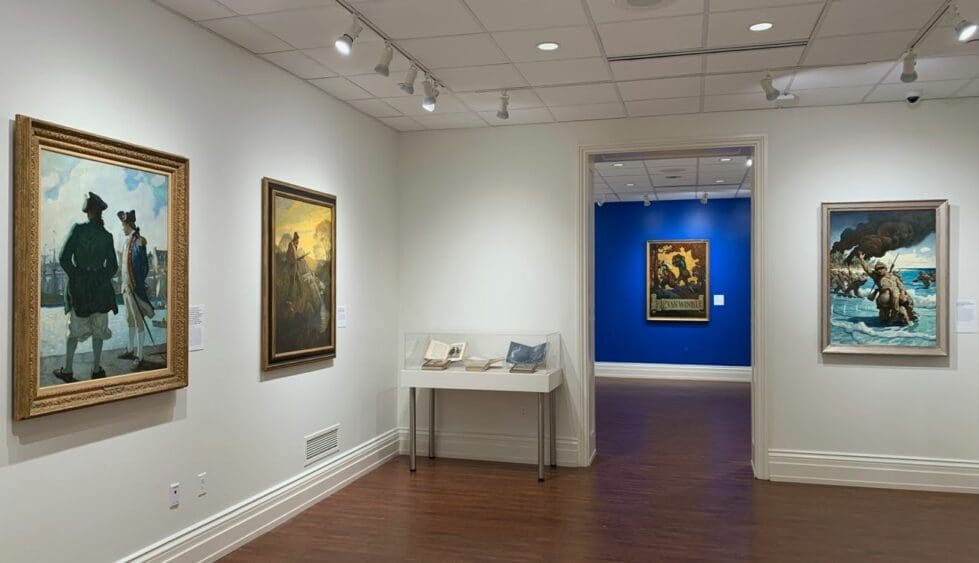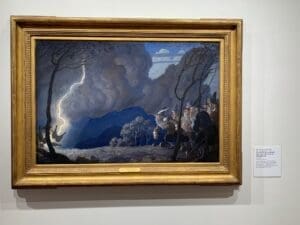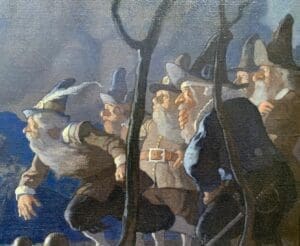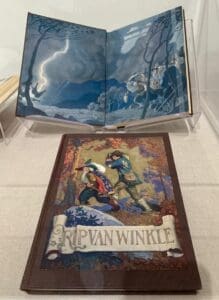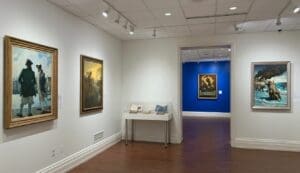
“The Wyeths: Three Generations” opens with a retrospective of patriarch N.C. Wyeth’s illustrations.
“The Wyeths” took their darn sweet time getting to Dover.
But now through Feb. 11, an exhibition of 70-plus works by the famous family of artists will fill nine rooms at the Biggs Museum of American Art and spark lots of other events.
It is the biggest exhibition yet for the Biggs, which focuses on MidAtlantic art, said Michael Dudich, director of the museum.
The exhibit is culled from works that were bought by MBNA, a banking company that made its name on credit card processing and once dominated financial business in Wilmington and New Castle County.
When MBNA sold to Bank of America, the art went with it and now is shown around the country in BOA’s Art in our Communities program.
“This is the first time that these works have ever been shown in Delaware, even though they were acquired in Delaware,” Dudich said. “One of the benefits of the Art in the Communities program from Bank of America is they provide the entire exhibition. They send it to us, we then interpret it and we put it up on the walls and decide how to display it. And then we basically ship it back and it goes to the next location.”
Biggs Curator Laura Fravel chose how to display the paintings, including the color of the walls on which they are shown.
The program is a boon for smaller museums who may not have the bandwidth to mount such a show.
The full name of the exhibition, “The Wyeths: Three Generations.” refers not only to famed painters N.C. Andrew and Jamie — father, son and grandson — but also Andrew’s sister, Henrietta, and her husband, Peter Hurd.
The Wyeths lived in Delaware and Chadds Ford, Pennsylvania, and many in the state consider them local artists.
The Biggs gave members of its annual gala a sneak peek of the show and had a private opening Thursday, during which Victoria Wyeth — Andrew’s granddaughter and Jamie’s niece — spoke.
The big Biggs bash is this weekend – Nov. 3-5 — and will include a 6:30 p.m. to 8 p.m. Friday by Victoria on “Andrew Wyeth: Then and Now.”
Admission to the Biggs is free on the first weekend of each month that “The Wyeths” will be running, and that includes the weekend of Nov. 3-5.
Victoria will headline a Family Studio event, “Making Scarecrows,” Saturday from 11 a.m. to 2 p.m.
And the exhibit will be the subject of a First Saturday Free Tour from 2 p.m. to 3 p.m.
The Wyeth patriarch
The Biggs display is organized in chapters, with one dedicated to patriarch N.C., one to his son Andrew, one to grandson Jamie and one to Henrietta and Peter Hurd.
N.C. was an illustrator whose large paintings were sent to publishers, where they were turned into pages in books or magazines.
One of the joys of the exhibit is being able to see something like N.C.’s paintings for “Rip Van Winkle” in the size he painted them, and then see the cover of the book and the detailed frontispiece in a case next to the painting.
“We didn’t have photography,” Dudich said. “When we were printing magazines in the late 1800s, early 1900s, 1920s, this was the way in which they illustrated stories in the magazines and the envelopes.”
One fun grouping shows photos by famed photographer Margaret Bourke-White showing some of N.C.’s murals installed on office walls.
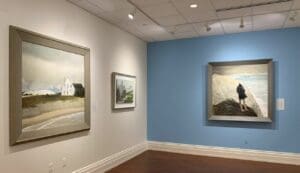
Andrew Wyeth, who gained fame as a modern painter, was a master at making paintings feel personal, the Biggs director said.
Andrew Wyeth
One of the reasons that Dudich likes Andrew Wyeth is because his art appears to be much more personal than that of N.C., who famously advised his son not to go into illustration beause he would never be taken seriously as a fine arts painter.
Andrew did so some illustrations, though, and Dudich points to a work for the book “Bedford Village,” which shows a redcoat standing guard over snowy fields.
“It’s not personal in terms of the fact that he is painting people that he knows or situations that he’s involved in, but when you look at the work you feel as though you’re there,” he said. “When you look at when you look at this painting of Bedford village from 1943, you can actually get a sense of what it was like for that soldier to be standing there.”
RELATED STORY: The Delaware Art Museum’s unblinking look at the cost of creativity
It helped, he said, that Andrew did not hire models. He preferred to paint people he knew, and the exhibit includes examples of that.
Visitors may see some similarities between N.C. and Andrew, he said.
“But you’re going to get to see how each of these people matured individually as artists,” he said. “So where you were looking at ‘Bedford Village,’ where Andrew was doing an illustration similar to his father, he eventually moved away from that and to his own genre of work. And his own style, in his own areas of interest, where none of these were illustrations.”
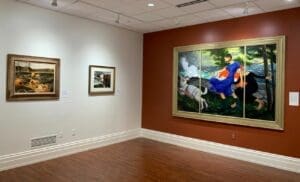
The Biggs section on Jamie Wyeth seems to combine the bold coloring and statements of his grandfather with the restraints of his father.
Jamie Wyeth
Jamie’s art seems to embrace what was often the dramatic colors of his grandfather and subtle shadings of his father.
But, as ‘The Wyeths’ shows, he had some works that would have been hard to tell apart from his father’s in theme and coloring.
Jamie also worked as an illustrator. When he was in the Delaware Air National Guard, he drew cartoons and illustrated articles for the base newspaper, “The DANG Truth.”
“So it’s very interesting to see how the idea of illustration flowed through all their lives,” Dudich said.
Those pieces will be the subject of a Nov. 11 Veterans Day lecture by Delaware Military Museum Curator Kennard R. Wiggins Jr. The 11 a.m. speech will have a $10 donation requested to benefit Wreaths Across America.
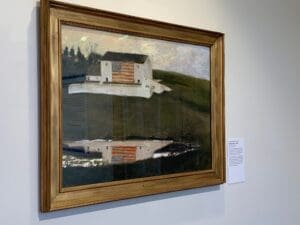
Jamie Wyeth’s “Patriots Barn.”
Dudich said he would agree with people who say there has been a Wyeth for each generation.
He points to Jamie’s worth with dancer Rudolph Nureyev.
“We’re so fortunate to have this painting in the collection because it is such a big part of Jamie’s history,” he said.
Jamie also stands apart from his father and grandfather in his embrace of scale. Many of this pieces, like 1999’s “The Tempest: A Triptych” are huge.
Other pieces, such as a white barn emblazoned with the American flag, called “Patriots Barn” and painted after the 9/11 attacks, are a more typical size and feel like a statement.
Dudich said he things all of the Biggs exhibitions are great. One of its missions is to highlight regional artists and one reason its exhibits are successful is because visitors can discover someone they never knew about.
But “The Wyeths” is supersized for the Biggs.
“It’s big names,” he said. “And I think you’re always excited to have something that will resonate broadly.”
IF YOU GO
The Biggs Museum of American Art is open from 10 a.m. to 5 p.m. Thursday through Sunday. It’s located at 43 The Green, Dover. Admission is $10 adults; $8 for seniors; children and military admitted for free. (302) 674-2111

Betsy Price is a Wilmington freelance writer who has 40 years of experience, including 15 at The News Journal in Delaware.
Share this Post


